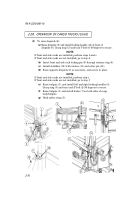TM-9-2320-386-10 - Page 117 of 223
TM 9-2320-386-10
2-84
2-34. OPERATION IN EXTREME HEAT
a. General.
Extreme heat exists when outside temperature exceeds 95°F
(35°C). The effect of extreme heat on vehicle engine is a decrease in engine efficien-
cy. Operators must adjust driving when operating in extreme heat.
b. Before Operation.
(1)
Perform “before operation” PMCS (table 2-2).
.
WARNING
.
Compressed air used for cleaning purposes will not exceed 30 psi
(207 kPa). Use only with effective chip guarding and personal
protective equipment (goggles/shield, gloves, etc.).
(2)
Check for sand and insects embedded in front of radiator, charged air
cooler, and auxillary transmission oil cooler. Blow out all such obstructions with
compressed air.
(3)
If vehicle is to be operated in deep sand, place ECU (1) to “S” (sand/mud/
snow) setting to deflate tire pressure to 18-22 psi (124-152 kPa) (para. 2-19).
NOTE
Avoid continuous vehicle operation at high speeds. Avoid long,
hard pulls on steep grades with transfer case shift lever in LOW
position.
c. Driving Vehicle.
(1)
Start engine (para. 2-12).
NOTE
If vehicle is to be operated in dusty or sandy areas, place trans-
mission select lever in “2” (second) position and transfer case shift
lever in LOW position.
(2)
Place vehicle in motion (para. 2-15).
(3)
Frequently check air cleaner indicator (5). If indicator (5) shows yellow,
stop the vehicle and engine (para. 2-16) and perform emergency air cleaner service
(para. 3-8).
(4)
Frequently check engine coolant temperature gauge (2), engine oil pres-
sure gauge (4), and transmission oil temperature gauge (3). Engine or transmission
is overheating if one or more of the following conditions exist:
(a)
Engine coolant temperature is more than 230°F (110°C) as indicated
by engine coolant temperature gauge (2).
(b)
Engine oil pressure drops below 15 psi (103 kPa) with engine at idle
as indicated by engine oil pressure gauge (4).
(c)
Transmission oil temperature exceeds 300°F (149°C) as indicated by
transmission oil temperature gauge (3).
Back to Top




















